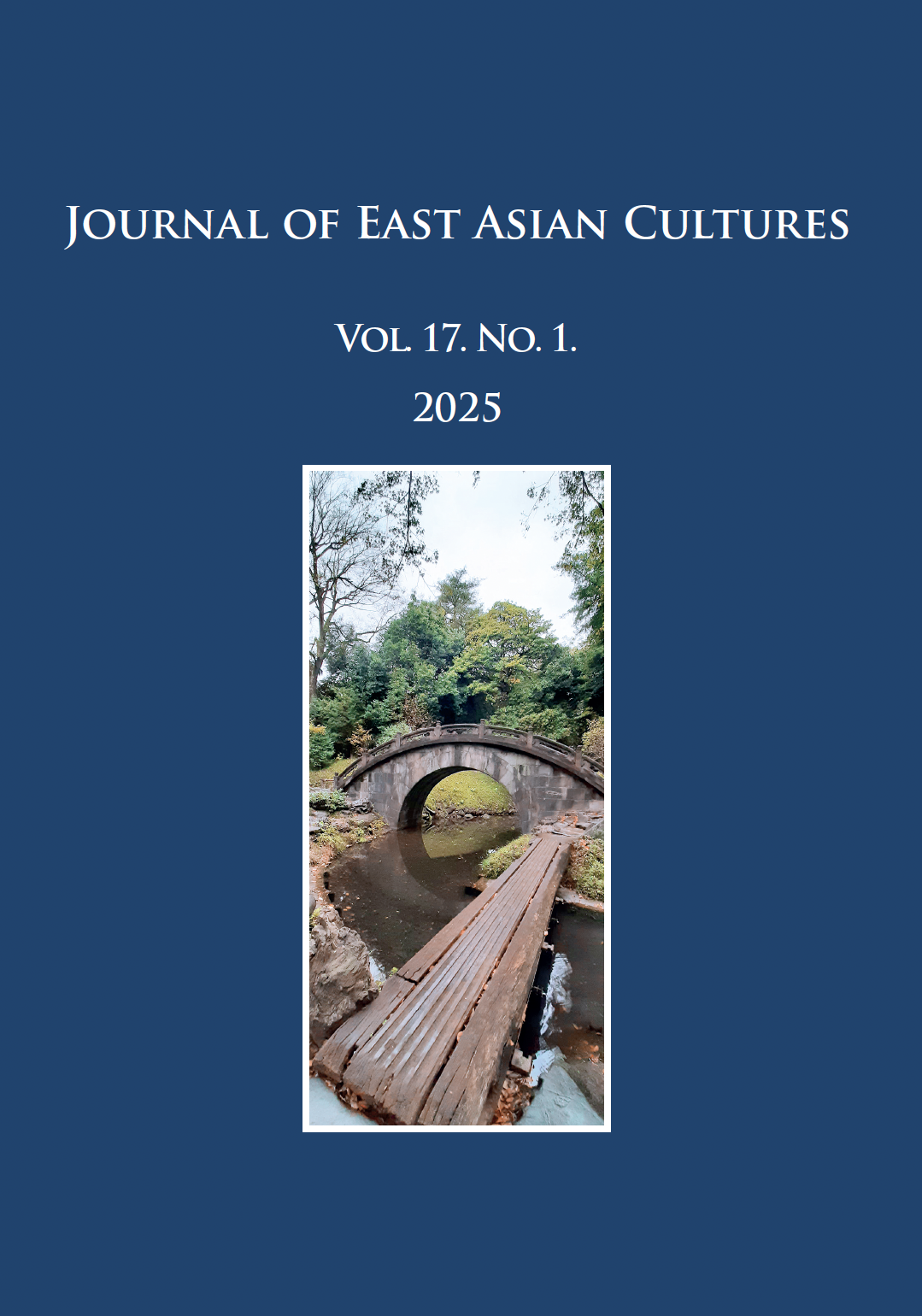The Śāriputra and Raudrākṣa – On the Identity of the Bronze Drum in the Dunhuang Murals
Megjelent 2025-01-02
Kulcsszavak
- bronz dob,
- Yulin 16-os sír,
- Dunhuangi barlangok,
- keresztmintázat,
- heterodox tanok
- Tianzhu ...Tovább
Hogyan kell idézni
Copyright (c) 2025 Minqian Liao

This work is licensed under a Creative Commons Attribution-NonCommercial 4.0 International License.
Absztrakt
The story of Śāriputra and Raudrākṣa (Laoducha shengdou bian 勞度叉聖鬥變) involves Minister Sudatta’s encounter with the Buddha while seeking a bride for his son. Sudatta’s conversion leads to the construction of a monastery, sparking a contest between Buddhist monks and six sectarian teachers, with Śāriputra’s victory over Raudrākṣa showcasing Buddhist supremacy. The Dunhuang murals, based on the Xiangmo bianwen 降魔變文 (The Demon Conquering Story), are derived from the Buddhist Xian yu jing 賢愚經 (Sūtra of the Wise and the Foolish) and reflect a complex relationship between scripture, bianwen 變文, and the murals. This article explores how these forms differ while maintaining a connection, focusing on the dharma combat scenes and the symbolic use of dharma instruments. The cross-patterned jin drum (jin gu 金鼓) in the contest between Śāriputra and Raudrākṣa is a fascinating element embedded in the broader context of Dunhuang murals, manuscripts, and the religious and cultural symbolism of late Tang dynasty art. The article inquiry into the interpretation of the jin drum, its identity, and the significance of the cross pattern involves a detailed examination of archaeological, artistic, and textual evidence.
The analysis of the Śāriputra and Raudrākṣa contest in Dunhuang murals and manuscripts, such as P.Tib.1293, reveals that the cross pattern on the jin drum holds deeper symbolic meaning beyond a ruptured drum skin. Traditionally, the cross pattern was thought to symbolise a ‘broken drum skin’ or ‘wind-broken drum’, representing the defeat of Raudrākṣa’s followers. However, this interpretation is challenged, suggesting that the pattern may have connections to the cultural and religious significance of bronze drums used by southern ethnic minorities in China. The cross-patterned drum is identified as a bronze drum, similar to the Chongyang 崇陽 bronze drum, and linked to the metal classification of ancient Chinese musical instruments. These drums were sacred objects used in rituals to communicate with deities, particularly among southern Chinese ethnic groups. The drum’s depiction in the contest scene reflects the clash between Buddhism and indigenous religious practices, symbolising the transition from animism and shamanism to Buddhist dominance. The broader cultural significance of this transformation highlights how Buddhism absorbed and transformed the religious symbols of local traditions, with the bronze drum serving as a metaphor for this shift. Ultimately, the jin drum in these murals represents not a rupture, but a deeper connection to the shamanistic traditions of the southern ethnic minorities and their gradual integration into Buddhist culture during the Tang dynasty.
Hivatkozások
- Primary Sources
- Tongdian 通典 [Comprehensive Statutes]. Ed. Wang Wenjin 王文錦. Beijing: Zhonghua Book
- Company, 2016.
- Sui shu 隋书 [The Book of Sui]. Beijing: Zhonghua Book Company, 2018.
- Xian yu jing 賢愚經 [Sūtra of the Wise and the Foolish]. Beijing: Dazhong Wenyi Publishing
- House, 2004.
- Zhouli 周禮 [The Rites of Zhou]. Beijing: Zhonghua Book Company, 2022.
- Secondary literature
- Akiyama Terukazu 秋山光和 1960. ‘Tonkō ni okeru henbun [bianwen] to kaiga 敦煌における
- 変文と絵画 [Bianwen and Paintings in Dunhuang].’ The Bijutsu Kenkyū: The Journal of Art
- Studies 211: 1–28.
- Guo Hong 郭宏 – Huang Huaiwu 黃槐武 – Xie Riwan 謝日萬 – Lan Riyong 藍日勇 2004.
- ‘Guangxi Zuojing Yanhuade Yishu Tezheng ji Jiazhi 廣西左江岩畫的藝術特徵及其價值
- [Artistic Characteristics and Value of the Cliff Paintings in the Zuojiang Region, Guangxi].’
- Dongnan Wenhua 東南文化2004.2: 5.
- Keown, Damien 2004. ‘Six Teachers Criticized by the Buddha.’ In: A Dictionary of Buddhism. Oxford:
- Oxford University Press, 350. https://doi.org/10.1093/acref/9780198605607.001.0001
- Li Yongning 李永寧 – Cai Weitang 蔡偉堂 2000. ‘Xiang Mo Bian Wen yu Dunhuang Bihua
- zhong de Laoducha Dousheng Bian《降魔變文》與敦煌壁畫中的“勞度叉斗聖變” [The
- article The Demon Conquering Bianwen and the Śāriputra and Raudrākṣa in Dunhuang Murals].’
- In: Dunhuang Institute of Cultural Relics and Archaeology (ed.) 1983 nian quanguo
- Dunhuang xueshu taolunhui wenji shiku yishu bian (shang) 1983 年全國敦煌學術討論會文
- 集 ̇石窟藝術編(上). Lanzhou: Gansu Nationalities Publishing House, 134–150.
- Li Yongqiang 李永強 2010. ‘Gudai Tonggu Shang Taiyang Wenshi Chansheng de Lishi Yuanyuan
- ji Wenhua Neihan 古代銅鼓上太陽紋飾產生的歷史淵源及文化內涵 [Historical Origins
- and Cultural Connotations of Sun Patterns on Ancient Bronze drums].’ Art Exploration
- 4: 35. https://doi.org/10.3969/j.issn.1003-3653.2010.04.012
- Lu Yunda 陸雲達 2016. ‘Zhongguo Meishu: Tuwen Zhen Cang Ban 中國美術:圖文珍藏版 [Chinese
- Art: Illustrated Edition].’ Shantou: Shantou University Press.
- Sha Wutian 沙武田2007. ‘Dunhuang Huagao Yanjiu 敦煌畫稿研究 [Dunhuang Research Sketches].’
- Beijing: Central Compilation & Translation Press. https://doi.org/10.7666/d.J0044733
- Wang Ling 王玲 2017. ‘The Symbolism and Reference Value of Musical Imagery in the Nanzhao
- Tuzhuan.’ Renmin yinyue 人民音樂 2017.6: 59.
- Wu Hong 巫鸿 2023. Tangdai Yishu, ‘Wenxue he Jiangchang Biaoyan de Baoguizhengju 唐代藝
- 術、文學和講唱表演的寶貴證據 [Valuable Evidence of Tang Dynasty Art, Literature, and
- Storytelling Performances].’ Dunhuang yanjiu 敦煌研究 2023.5: 25.
- Yin Guangming 殷光明 2001. ‘Cong “Zhi Yuan Jing She Tu” dao “Lao Du Cha Dou Sheng
- Bian” de Zhuti Zhuanbian yu Fo Dao Zhi Zheng 從《祗園精捨圖》到《勞度叉鬥聖變》
- 的主題轉變與佛道之爭 [From the Jetavana Vihara Picture to the Theme Transformation and
- Buddhist-Taoist Conflict in the Śāriputra and Raudrākṣa Murals].’ Dunhuang yanjiu 敦煌研
- 究 2001.2: 4–13+185. https://doi.org/10.3969/j.issn.1000-4106.2001.02.002
- Zhu Xiaofeng 朱曉峰 2017. ‘Dunhuang huagao zhong de yinyue tuxiang yanjiu 敦煌畫稿中的
- 音樂圖像研究 [Research on Musical Imagery in Dunhuang Paintings].’ Dunhuang yanjiu 敦
- 煌研究 2017.2: 85–101. https://doi.org/10.3969/j.issn.1001-6252.2017.02.008
- Zhuang Zhuang 庄壮 2002. ‘Dunhuang bihua shang de daji yueqi 敦煌壁畫上的打擊樂器
- [Percussion Instruments in Dunhuang Murals].’ Yinxiang 音響 2002.4: 15–22. https://doi.
- org/10.3969/j.issn.1003-1499.2002.04.003

